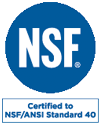OxyPro
 |
Certain models of the OxyPro have been tested and are listed under NSF/ANSI Standard 40 and are hereby certified as Class I Aerobic Wastewater Treatment Plants. |
The
OxyPro 1000 is an innovative wastewater treatment unit designed
to handle flows up to 500 gallons per day. It combines the
best design components of modern aeration methods and avoids
unnecessary complexity in both installation and operation.
The OxyPro is suitable for installation in new septic systems
as well as an addition to existing systems in order to increase
the capacity of the disposal area.
There
are several advantages to using the OxyPro Wastewater Treatment
system:

- Extending
the life of a disposal area.
- Reducing
the required size of the disposal area.
- Removal
of nitrates in the wastewater.
- Reduced
risk of environmental pollution.
OxyPro
is designed with the owner in mind. All outside components
are buried out of sight, and the control and blower enclosures
may be mounted inside in a storage or utility space. OxyPro
is quiet, inexpensive to operate, and requires little maintenance.
Each unit is constructed using the highest quality materials
and methods to ensure reliability and longevity. Aeration
Systems, LLC warrantees each unit for an initial two-year
period and offers a variety of extended service contracts.
The
OxyPro Wastewater Treatment system is available in a variety
of models:
- The
Oxypro comes standard in a concrete tank for ease of
installation on most sites, but is also available
in plastic tanks for difficult sites where access is
limited.
- The
OxyPro is available with a gravity or pumped outlet,
depending on the site requirements.
- The
Oxypro can be supplied with all of the headworks necessary
to be used with a pressurized drip irrigation disposal
system.
- Where
disinfection of the wastewater is required prior to
disposal, a sterilizing ultraviolet unit is available.
For people seeking a quality cost-effective solution to wastewater
treatment, OxyPro is the best choice.
The Process
Septic Tank:
Wastewater from the house flows into a septic tank sized
according to State Code. In the septic tank, settling occurs
with the formation of sludge and scum. This material is
removed periodically by a pump truck. Clarified wastewater
flows through a filter and into the OxyPro tank.
Aeration Treatment Unit:
The
first (inlet) compartment of the OxyPro tank is the aeration compartment.
Air is pumped under pressure from an efficient, linear-diaphragm
pump through flexible-membrane bubble diffusers anchored to the
bottom of the tank. This creates a number of curtains of
tiny air bubbles, which allow for excellent oxygen transfer efficiency.
Through this process of aeration, an aerobic environment is established
in which oxygen-loving microorganisms can flourish and digest
the organic material in the wastewater. These microorganisms
grow on a synthetic ribbon media suspended in the water column
and form large colonies, visible to the naked eye. Eventually,
these colonies become too large and heavy, and due to the agitation
caused by aeration, slough off. The sloughed colonies are
carried by the wastewater into the next compartment.
The
second compartment is designed as an upflow clarifier. This
means that the wastewater is given a calm environment where it
flows slowly upward to the outlet. The quiescent environment
allows the sloughed colonies and other suspended particles to
settle to the bottom of the clarifier. A submersible pump
periodically pumps the accumulated sludge from the bottom of the
clarifier to the septic tank, where it is ultimately removed when
the septic tank is serviced. The return of this water to
the anaerobic carbon-rich environment of the septic tank also
serves to enhance denitrification, typically resulting in a 50%
reduction of total nitrogen. The cleaned and clarified effluent
from the OxyPro flows out of the treatment module and on to a
subsurface disposal area.
The
operation of the OxyPro is fully automated and controlled by a
programmed computer module. This control panel operates
the pumps and blower, and is equipped to detect a mechanical failure
of the blower, as well as unusual water levels in the tank.
In the event of such a problem, the panel is equipped with both
audio and visual alarms to alert the owner. Remote alarms
are also available to alert Aeration Systems representatives directly.
Technical Information